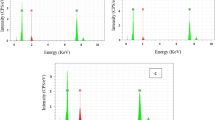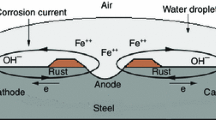Abstract
Resin films based on polyurethane dispersions (PUDs) have recently gained substantial interest as surface protective coatings. However, defects in the resin films such as micro-cracks may induce high permeability to moisture, thereby compromising the coatings’ performance. In this contribution, we report on a simple electrochemical method for characterization of the micro-cracks in a resin film deposited on a copper surface. Electrochemical measurements are facilitated in a two-electrode cell where the resin-coated copper electrode serves as the anode. The ionic current flow due to electrolyte penetration within the micro-cracks of the resin film is measured and quantified. The ionic current (I) exhibits an inverse exponential dependence on the film thickness (x): I ∝ e−x. The physical basis for this dependence is discussed using a mathematical model that incorporates the surface fraction of micro-cracks in a layered resin film. While the analysis presented herein is for the specific case of PUD resins, the overall methodology is applicable to the characterization of many metallic and non-metallic surface coatings used in corrosion protection and surface functionalization applications.
Graphical abstract






Similar content being viewed by others
References
Engbert T, Bock M, Kirihara O (1999) High performance polyurethane clearcoats for automotive OEM. J Jpn Soc Colour Mater 72(2):102–107
Melchiors M, Sonntag M, Kobusch C, Jürgens E (2000) Recent developments in aqueous two-component polyurethane (2K-PUR) coatings. Prog Org Coat 40:99–109
Wicks ZW Jr, Wicks DA, Rosthauser JW (2002) Two package waterborne urethane systems. Prog Org Coat 44:161–183
Noble K-L (1997) Waterborne polyurethanes. Prog Org Coat 32:131–136
Steward PA, Hearn J, Wilkinson MC (2000) An overview of polymer latex film formation and properties. Adv Colloid Interface Sci 86:195–267
Armstrong RD, Wright JD (1992) Impedance studies of polyethylmethacrylate coatings formed upon tin-free steel. Corros Sci 33(10):1529–1539
Balik CM, Said MA, Hare TM (1989) Residual porosity in polymeric latex films. J Appl Polym Sci 38:557–569
Roulstone BJ, Wilkinson MC, Hearn J (1991) Studies on polymer latex films: III. Permeability of latex films to aqueous organic solutes. Polym Int 27:51–55
Roulstone BJ, Wilkinson MC, Hearn J (1991) Studies on polymer latex films: IV. Comparison of the permeability of latex and solvent-cast films. Polym Int 27:305–308
Giesche H (2006) Mercury porosimetry: a general (practical) overview. Part Part Syst Charact 23:1–11
Boissiere C, Grosso D, Lepoutre S, Nicole L, Bruneau AB, Sanchez C (2005) Porosity and mechanical properties of mesoporous thin films assessed by environmental ellipsometric porosimetry. Langmuir 21(26):12362–12371
Defranoux C, Bondaz A, Kitzinger L, Walsh C (2007) Ellipsometric porosimetry: fast and non-destructive method of porosity characterization of mesoporous thin films: example on cubic TiO2 (abstract 1320). In: 211th Electrochemical Society Meeting, May 6–10 2007, Chicago
Vayer M, Nguyen TH, Grosso D, Boissiere C, Hillmyer MA, Sinturel C (2011) Characterization of nanoporous polystyrene thin films by environmental ellipsometric porosimetry. Macromolecules 44(22):8892–8897
Wang CL, Krim J (1989) Roughness and porosity characterization of carbon and magnetic films through adsorption isotherm measurements. J Vac Sci Technol A 7(3):2481–2485
Cuperus FP, Bargeman D, Smolders CA (1992) Permporometry: the determination of the size distribution of active pores in UF membranes. J Membr Sci 71(1–2):57–67
Krantz WB, Greenberg AR, Kujundzic E, Yeo A, Hosseini SS (2013) Evapoporometry: a novel technique for determining the pore-size distribution of membranes. J Membr Sci 438:153–166
Landry M (2005) Thermoporometry by differential scanning calorimetry: experimental considerations and applications. Thermochim Acta 433(1–2):27–50
Tsuru T, Hino T, Yoshioka T, Asaeda M (2001) Permporometry characterization of microporous ceramic membranes. J Membr Sci 186(2):257–265
Alfeel F, Awad F, Alghoraibi I, Qamar F (2012) Using AFM to determine the porosity in porous silicon. J Mater Sci Eng A 2(9):579–583
Ma Y, Davis HT, Scriven LE (2003) Microstructure development in drying latex coatings. Prog Org Coat 52:46–62
Roulstone BJ, Wilkinson MC, Hearn J, Wilson AJ (1990) Studies on polymer latex films: I. A study of latex film morphology. Polym Int 24:87–94
White SR, Sottos NR, Geubelle PH, Moore JS, Kessler MR, Sriran SR, Brown EN, Viswanathan S (2001) Autonomic healing of polymer composites. Nature 409(6822):794–797
Mansfeld F (1995) Use of electrochemical impedance spectroscopy for the study of corrosion protection by polymer coatings. J Appl Electrochem 25(3):187–202
McIntyre JM, Pham HQ (1996) Electrochemical impedance spectroscopy; a tool for organic coatings optimizations. Prog Org Coat 27(1–4):201–207
Olivier MG, Poelman M (2012) Use of electrochemical impedance spectroscopy (EIS) for the evaluation of electro-coatings performances. In: Razavi RS (ed) Recent researches in corrosion evaluation and protection. InTech, Rijeka, pp 1–26
González-García Y, González S, Souto RM (2007) Electrochemical and structural properties of a polyurethane coating on steel substrates for corrosion protection. Corros Sci 49:3514–3526
Taberna PL, Simon P, Fauvarque JF (2003) Electrochemical characteristics and impedance spectroscopy studies of carbon–carbon supercapacitors. J Electrochem Soc 150(3):A292–A300
Patel CJ, Mannari V (2014) Air-drying bio-based polyurethane dispersion from cardanol: synthesis and characterization of coatings. Prog Org Coat 77(5):997–1006
Price DC, Davenport WG (1980) Densities, electrical conductivities and viscosities of CuSO4/H2SO4 solutions in the range of modern electrorefining and electrowinning electrolytes. Metall Trans B 11:159–163
Acknowledgments
The authors would like to acknowledge Sherwin-Williams for supplying materials for fabricating the resin films. Professor Donald Feke is acknowledged for valuable discussions. Financial support for this research was provided by the Department of Chemical and Biomolecular Engineering at Case Western Reserve University.
Author information
Authors and Affiliations
Corresponding author
Ethics declarations
Conflict of interest
The authors declare that they have no conflicts of interest.
Rights and permissions
About this article
Cite this article
Rao, K.K., Ferguson, M., Murphy, K. et al. Electrochemical characterization of micro-cracks in polyurethane resin films deposited on metallic surfaces. J Appl Electrochem 46, 1237–1243 (2016). https://doi.org/10.1007/s10800-016-1005-6
Received:
Accepted:
Published:
Issue Date:
DOI: https://doi.org/10.1007/s10800-016-1005-6




